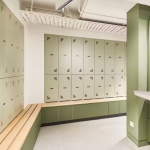Steel lockers are a cornerstone of organized and secure storage in countless environments, from schools and gyms to offices and industrial facilities. Their durability, security, and cost-effectiveness make them a popular choice. However, not all steel lockers are created equal. Understanding the different types available is key to selecting the right locker for your specific needs.
The main variations can be categorized by design, ventilation, door style, and intended use.
1. By Design and Ventilation
Full-Height Lockers
These are the classic, single-door lockers that offer a large, unobstructed storage space from top to bottom. Ideal for storing long items like coats, bags, or even musical instruments, they provide maximum hanging space.
Best for: Schools, workplaces, changing rooms where users need to store full-length garments.
Standard Lockers (Single-Tier)
These are the most common type, typically around 72 inches high, 12 inches wide, and 15 inches deep. They offer a versatile storage solution for a combination of hanging and shelved items.
Best for: General-purpose use in gyms, factories, and communal areas.
Multi-Tier / Banked Lockers
To maximize space efficiency, multi-tier lockers stack two or three compartments vertically. This creates separate storage units for multiple users within the same floor footprint.
Double-Tier: Two lockers stacked, perfect for facilities with high user turnover.
Triple-Tier: Three lockers stacked, offering the highest density for spaces like large event venues or employee locker rooms.
Best for: High-capacity needs in gyms, water parks, and industrial plants.
Vented Lockers
These lockers feature perforated steel sheets (typically on the door and sides) to allow for maximum air circulation. This is crucial for drying damp clothing, towels, or athletic gear, preventing mildew and unpleasant odors.
Best for: Gyms, swimming pools, sports facilities, fire stations, and any environment where wet items are stored.
Solid Lockers
As the name implies, these lockers are constructed from solid, non-perforated steel panels. They offer superior security and privacy, as the contents cannot be seen or accessed through the vents.
Best for: Offices, warehouses, and industrial settings where securing valuable tools, equipment, or personal electronics is a priority.
2. By Door Style
Single-Tier Lockers
A single door that opens to one full compartment. This is the simplest and most common design.
Double-Tier Lockers
This design features two separate doors—one for the upper compartment and one for the lower—within a single locker frame. It functions like two banked lockers but is often purchased as a single unit.
Tier-on-Tier Lockers
Similar to double-tier, but the upper and lower sections are individual lockers that can be separated and reconfigured. This offers greater flexibility for future layout changes.
Lockers with Sliding Doors
Instead of swinging outward, these doors slide horizontally on a track. This is a major space-saving advantage in narrow corridors or tight spaces where a swinging door would be an obstruction.
Bes t for: Hallways, changing rooms with limited aisle space, and modern office designs.
3. By Locking Mechanism
Keyed Lockers
The traditional choice. Each locker has its own unique key. While simple, key management can become challenging if many keys are involved, and there is a cost associated with replacing lost keys.
Combination Lockers
These feature a built-in dial combination lock. They eliminate the need for keys, but combinations can be forgotten and may need to be reset by management.
Padlock-Compatible Lockers
These are the most flexible option. They feature a simple latch with a hasp, allowing users to supply their own padlock (either keyed or combination). This is common in schools, gyms, and rental facilities.
Electronic Lockers
The modern solution, offering high security and advanced features. These can include digital PIN codes, RFID card/fob access, or even biometric scanners. They allow for easy code resets and can integrate with access control systems.
Best for: High-security areas, corporate environments, and facilities where user access needs to be frequently changed or monitored.最适合: 需要频繁更改或监控用户访问的高安全性区域、企业环境和设施。
4. By Specialized Function
Box Lockers / Package Lockers
These are small, cube-like lockers designed for storing books, packages, or personal items like phones and wallets. They are often used in arrays for temporary or parcel storage.
Athletic Lockers
Often wider and deeper than standard lockers, these are designed to hold sports equipment, helmets, and boots. They may include extra shelves or specific compartments.
Ventilated Shoe Lockers
Very narrow lockers specifically designed for storing footwear, promoting air circulation to keep them dry.
Corner Lockers
Triangular in design, these are made to fit neatly into a corner, utilizing space that would otherwise be wasted.
Choosing the Right Steel Locker
When selecting steel lockers, consider the following:
- Environment: Is it a wet gym or a dry office?
- Space: Do you need to maximize capacity with multi-tier units, or save aisle space with sliding doors?
- Security Needs: Are you storing coats or valuable tools?
- User Convenience: Is key management a burden? Would electronic access be better?
- Durability: Consider the gauge of the steel and the quality of the finish (e.g., powder coating for corrosion resistance).
By understanding the different types of steel lockers, you can make an informed decision that enhances organization, security, and efficiency in your space for years to come.




